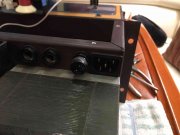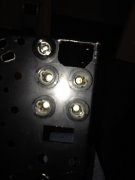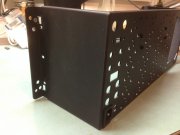Hi Joe, thanks again. My old offset meters PL700 has a plate mounted on the capacitor terminals but this plate is aluminum. My issue is more of a buzz mixed with hum. I think I have quoted this before;
"Another source is a signal lead running parallel to a mains power lead. Although the conductors of mains leads are twisted, the twist is usually fairly basic, so balancing of the magnetic field is rather poor compared to the tight twist of Cat-5 communications cable for example. The magnetic coupling is poor, and the greatest problems are likely to be caused by capacitive coupling. Since this favours high frequency noise, the sound is completely different from an earth loop, and it's a good idea to try to familiarise yourself with the different sounds made by the various issues that may plague hi-fi setups. If signal cables and mains wiring must cross each other, ensure they cross at right angles, and if possible separate the two as far as practicable. Capacitive coupling can also be an issue with transformer windings, where mains noise is coupled through to the secondary by inter-winding capacitance, or from Y-Class caps from mains to chassis"
As my approach seems to trial and error, what are your thoughts on creating a new, much heavier ground buss between the caps and make all connections by way of lugs soldered to the wires and held together on a centre mounted 1/4-20 copper stud. This would allow temporary removal of the transformer, extending the secondary leads to eliminate/determine the stray flux issue.
I will double check asap, but I believe I had a buzz even with the inputs shorted on the control board.
Hi Peter, there are many loops inside the amp subjected to the stray flux field besides the resistor you tacked on the input pins There are wires running everywhere inside the amp, all susceptible. Buzz and hum are both artifacts of possible stray flux fields.
Wouldn't it be a much simpler and quicker experiment to see if a tape covered (to prevent accidental shorts) steel plate inserted between the transformer and remainder of the amp makes a difference at all? If it makes no difference, then you have ruled that out.





